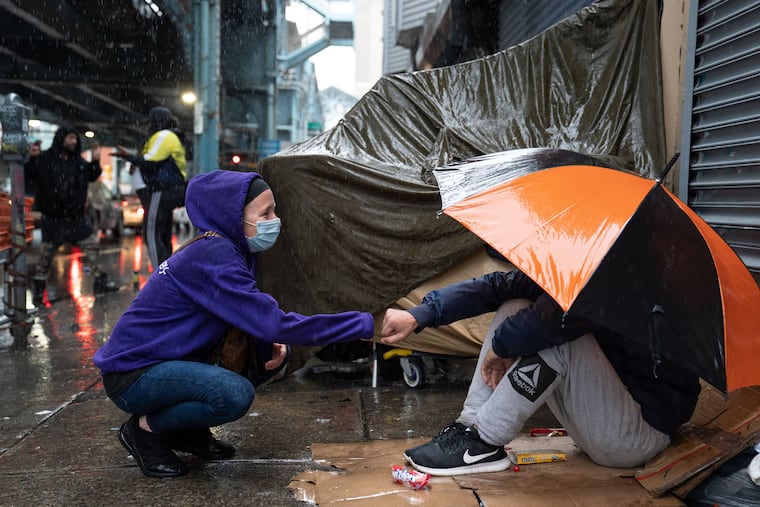Solutions for Kensington don’t begin or end with calling the National Guard
For change in Kensington, the scale of the solutions must be commensurate to the scale of the problem, and we must supplant ineffective approaches with a willingness to try new things.

A century ago, Kensington and Allegheny Avenues were the crossroads of the quintessential urban village, where workers walked from their rowhouses to the factories that drove Philadelphia’s industry, and the El train roared above a buzzing commercial corridor. In contrast, opioids now shape the area’s economy, geography, and image.
Gaunt figures use drugs, pitch tents, and do sex work along Kensington Avenue, and side streets are a mix of drug markets and besieged residents. Taken together, this section of Kensington has become a Gordian knot of urban ills.
Over the course of our research on homelessness in Kensington, we have spoken with residents who, understandably, ask why people breaking laws cannot simply be arrested and cleared out, and why residents cannot have a quality of life comparable with other city neighborhoods. Council members and other elected officials reinforce these sentiments. Mayor-elect Cherelle Parker has pledged to crack down on the drug markets and the homeless encampments and to enforce existing laws, possibly with a National Guard deployment.
However, we also spoke with police officials who were unanimous in their assessment that this is not a problem we can “arrest our way out of.” This is backed up by a litany of large-scale policing operations, with names such as Operation Sunrise and Operation Safe Streets, that have failed to leave any lasting benefit. While policing may be part of a solution, simply cracking down will not suffice.
And we have seen that alternatives to cracking down can work. In 2018, we observed and documented city initiatives that facilitated housing and treatment for people who were displaced from encampments, expedited the paperwork that allows people to enter detox programs, and enabled police to offer services as alternatives to arrest. Nonprofits have also responded, providing “low barrier” shelters that get people off the streets, mobile medical and substance use services, and outreach services considered among the best in the country.
We have seen such initiatives repeatedly help people make lasting exits from addiction and homelessness. However, the limited scope of these services means that, from a resident’s point of view, the drugs, homelessness, violence, and disorder seem as bad as ever. Two factors explain much of this.
The first one is scale. While attorney general, Gov. Josh Shapiro described the area’s opioid economy as “approaching a billion-dollar enterprise.” In contrast, other than periodic large-scale law enforcement initiatives, the response to the area’s drug economy has been minuscule. Scale is essential to make a dent in the problem, meaning the presence of ample resources for treatment, housing, jobs, and community revitalization.
More resources would allow the implementation of approaches such as “housing first” and medication-assisted treatment on demand, which we have seen work effectively in Philadelphia and in many other cities, to where they can make neighborhood-level differences.
Second, instead of having politicians call for yet another police sweep, we need to try new ideas that have shown promise. One example is supporting the shadow network of recovery housing that has quietly provided shared living accommodations and rehabilitation services for many who would otherwise be homeless.
Many of these providers are unlicensed. Incentives are needed to expand these programs and to enable providers to meet some basic standards that would allow them to operate effectively and weed out unscrupulous providers. Some coordination and funding through an intermediate nonprofit provider could help to bring standards and more units online.
Other approaches that have seen success are also worth exploring. Examples include expanding access to combined drug treatment and housing supports through Medicaid-funded programming, short-term or “shallow” rental assistance programs that can assist those with less intense treatment needs to regain stable housing, and support for people who might be able to obtain stabilized living arrangements with family.
For change in Kensington, the scale of the solutions must be commensurate to the scale of the problem, and we must supplant ineffective approaches with a willingness to try new things. These are tall orders, and there has been little indication of popular or political willingness to do either.
Unless this changes, resolution will come from real estate, the only sector that has invested in the area on a scale anywhere approaching that of the drug trade.
As the drugs, homelessness, and violence have worsened, investors have quietly bought up properties and have started building in areas that are on the edges of erstwhile drug corners and homeless encampments. Development is now moving up Kensington Avenue with little regard for the human misery in its way.
Neighborhood residents we spoke with six years ago were already aware of this trend and expressed ambivalence at how this process at once stood to save them and to exclude them. Gentrification could well transform Kensington, but it will not solve the homeless and opioid crises as much as move them along to other hapless neighborhoods.
Stephen Metraux is an associate professor at the University of Delaware’s Biden School of Public Policy and Administration. Dennis Culhane is the Dana and Andrew Stone Chair in Social Policy at the University of Pennsylvania.